Types of carp, discover 8 popular species
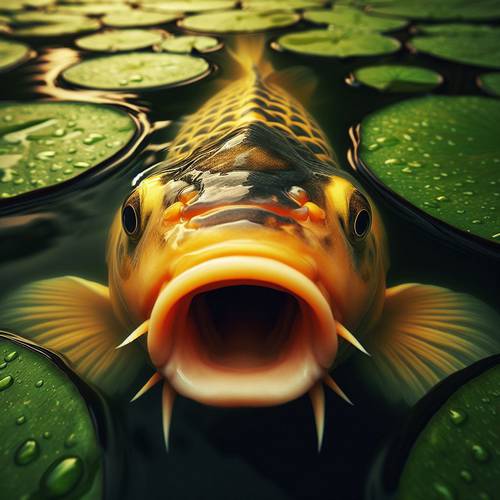
Discover the 8 most popular species
Carp fish are a type of freshwater fish that belong to the family Cyprinidae. Here are some of the main characteristics of carp fish:
Size: They Can vary in size, but they generally range from 10 to 40 inches in length and can weigh anywhere from a few pounds to over 100 pounds.
Appearance: The Carp have a stocky, cylindrical body shape and a slightly arched back. They typically have large scales and a slightly downturned mouth with four barbels (whisker-like projections) around it. Carp can also vary in color, with some species being bronze, brown, or green, and others having a golden or yellow hue.
Diet: Carp fish are omnivorous, which means they eat both plants and animals. Their diet can include insects, crustaceans, snails, and small fish, as well as aquatic plants and algae.
Habitat: Carp are native to Asia and Europe but have been introduced to other parts of the world, including North America. They prefer slow-moving or still waters such as ponds, lakes, and rivers.
Behavior: The fish are known for their strong swimming ability and can be quite active, especially during feeding times. They are also social creatures and can be found in schools or groups.
Lifespan: Carp fish can live for several decades in the right conditions, with some species living up to 50 years. Overall, carp fish are hardy, adaptable fish that can thrive in a variety of environments. They are also popular with anglers due to their large size and strength, as well as their willingness to take bait.
Size: They Can vary in size, but they generally range from 10 to 40 inches in length and can weigh anywhere from a few pounds to over 100 pounds.
Appearance: The Carp have a stocky, cylindrical body shape and a slightly arched back. They typically have large scales and a slightly downturned mouth with four barbels (whisker-like projections) around it. Carp can also vary in color, with some species being bronze, brown, or green, and others having a golden or yellow hue.
Diet: Carp fish are omnivorous, which means they eat both plants and animals. Their diet can include insects, crustaceans, snails, and small fish, as well as aquatic plants and algae.
Habitat: Carp are native to Asia and Europe but have been introduced to other parts of the world, including North America. They prefer slow-moving or still waters such as ponds, lakes, and rivers.
Behavior: The fish are known for their strong swimming ability and can be quite active, especially during feeding times. They are also social creatures and can be found in schools or groups.
Lifespan: Carp fish can live for several decades in the right conditions, with some species living up to 50 years. Overall, carp fish are hardy, adaptable fish that can thrive in a variety of environments. They are also popular with anglers due to their large size and strength, as well as their willingness to take bait.
Quick access to different kinds of carp.
Leather carp
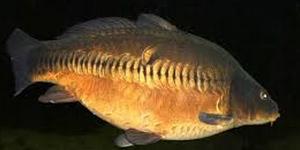
Leather carp (Cyprinus carpio var. unicolor) is a variety or subspecies of the common carp (Cyprinus carpio). It is a type of scaled carp that has a unique appearance due to the absence of normal scales on its body. Instead, the leather carp has a tough, leathery skin that is covered in a layer of slime. This skin provides some protection against predators, but it also makes the fish more susceptible to parasitic infections.
Leather carp are typically a dark, greyish-brown color with a yellowish underbelly. They can grow to be quite large, with some individuals reaching over 40 inches in length and weighing over 50 pounds. Like other carp species, they are omnivorous and will eat a variety of plant and animal matter.
This species are not as common as other types of carp, but they are still found in some fisheries and can be targeted by anglers. They are also used in aquaculture operations and are sometimes kept as ornamental fish in ponds and aquariums. However, their unique skin makes them less desirable for food than other types of carp, as the skin can be difficult to remove and has a tougher texture.
Leather carp are typically a dark, greyish-brown color with a yellowish underbelly. They can grow to be quite large, with some individuals reaching over 40 inches in length and weighing over 50 pounds. Like other carp species, they are omnivorous and will eat a variety of plant and animal matter.
This species are not as common as other types of carp, but they are still found in some fisheries and can be targeted by anglers. They are also used in aquaculture operations and are sometimes kept as ornamental fish in ponds and aquariums. However, their unique skin makes them less desirable for food than other types of carp, as the skin can be difficult to remove and has a tougher texture.
Grass carp
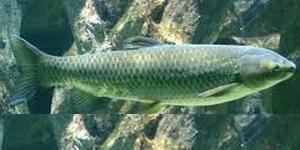
The grass carp (Ctenopharyngodon idella) is a species of freshwater fish that is native to eastern Asia, including China and Russia. It is a herbivorous fish that feeds primarily on aquatic plants and algae, and is sometimes used in aquaculture and fisheries management to control vegetation in lakes and ponds.
Here are some key features of the grass carp:
Appearance: Grass carp have a long, slender body that is typically olive-green or brownish in color. They can grow up to 4 feet in length and weigh up to 100 pounds, although most individuals are smaller than this.
Diet: The carp are herbivores and feed on aquatic plants, including algae, pondweeds, and watermilfoils. They have strong, ridged pharyngeal teeth that allow them to crush and grind tough plant material.
Habitat: They are typically found in slow-moving or still waters such as lakes, ponds, and rivers. They prefer clear, shallow water with plenty of vegetation.
Reproduction: Grass carp typically spawn in the spring, and females can produce up to 1 million eggs per year. They are not native to North America, but have been introduced to control aquatic weeds in some lakes and rivers.
Uses: In addition to their role in aquatic weed control, grass carp are also used in aquaculture to produce food for human consumption. However, there are concerns that escaped grass carp can become invasive and damage native ecosystems.
Overall, the grass carp is an important species in aquatic ecology and fisheries management, but it is important to carefully manage their use and prevent them from becoming invasive in non-native habitats.
Here are some key features of the grass carp:
Appearance: Grass carp have a long, slender body that is typically olive-green or brownish in color. They can grow up to 4 feet in length and weigh up to 100 pounds, although most individuals are smaller than this.
Diet: The carp are herbivores and feed on aquatic plants, including algae, pondweeds, and watermilfoils. They have strong, ridged pharyngeal teeth that allow them to crush and grind tough plant material.
Habitat: They are typically found in slow-moving or still waters such as lakes, ponds, and rivers. They prefer clear, shallow water with plenty of vegetation.
Reproduction: Grass carp typically spawn in the spring, and females can produce up to 1 million eggs per year. They are not native to North America, but have been introduced to control aquatic weeds in some lakes and rivers.
Uses: In addition to their role in aquatic weed control, grass carp are also used in aquaculture to produce food for human consumption. However, there are concerns that escaped grass carp can become invasive and damage native ecosystems.
Overall, the grass carp is an important species in aquatic ecology and fisheries management, but it is important to carefully manage their use and prevent them from becoming invasive in non-native habitats.
Bighead carp
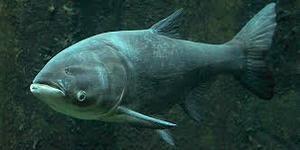
Bighead carp (Hypophthalmichthys nobilis) is a species of freshwater fish native to eastern Asia, including China and the Amur River basin. It is a type of Asian carp and is known for its large size and rapid growth rate.
Bighead carp has an elongated body and a large, protruding head with a blunt snout. They can grow up to 1.5 meters in length and can weigh over 40 kilograms. They have silver-colored scales and large eyes, and their fins are generally a pale color.
The carp are omnivorous and feed on plankton, algae, and other small organisms. They are also known to consume detritus and suspended organic matter. They are often considered an invasive species in areas where they have been introduced, as they can outcompete native fish for food and habitat, and reproduce rapidly.
In some cultures, bighead carp is considered a delicacy and is farmed for food. However, due to its invasive nature, it is important to manage bighead carp populations carefully to prevent negative impacts on the environment and other species.
Bighead carp has an elongated body and a large, protruding head with a blunt snout. They can grow up to 1.5 meters in length and can weigh over 40 kilograms. They have silver-colored scales and large eyes, and their fins are generally a pale color.
The carp are omnivorous and feed on plankton, algae, and other small organisms. They are also known to consume detritus and suspended organic matter. They are often considered an invasive species in areas where they have been introduced, as they can outcompete native fish for food and habitat, and reproduce rapidly.
In some cultures, bighead carp is considered a delicacy and is farmed for food. However, due to its invasive nature, it is important to manage bighead carp populations carefully to prevent negative impacts on the environment and other species.
Silver carp
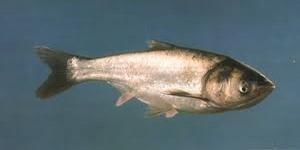
Silver carp is a species of freshwater fish native to the rivers of Southeast Asia. It is a member of the family Cyprinidae and is also known as the Asian carp. Silver carp have been introduced to other parts of the world, including the United States, where they were first brought in the 1970s to help control algae growth in aquaculture ponds.
The carp are known for their jumping ability and can leap up to 10 feet out of the water when startled by boats or other disturbances. They are also filter feeders, using their specialized gill rakers to strain small planktonic organisms from the water.
In the United States, silver carp have become an invasive species and are considered a threat to native fish populations and aquatic ecosystems. They have spread through the Mississippi River and its tributaries, and efforts are being made to control their populations and prevent further spread. Some people have also tried to find culinary uses for the fish in the United States, as it is considered a delicacy in some parts of Asia.
The carp are known for their jumping ability and can leap up to 10 feet out of the water when startled by boats or other disturbances. They are also filter feeders, using their specialized gill rakers to strain small planktonic organisms from the water.
In the United States, silver carp have become an invasive species and are considered a threat to native fish populations and aquatic ecosystems. They have spread through the Mississippi River and its tributaries, and efforts are being made to control their populations and prevent further spread. Some people have also tried to find culinary uses for the fish in the United States, as it is considered a delicacy in some parts of Asia.
Black carp
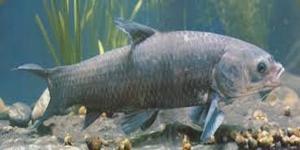
Black carp (Mylopharyngodon piceus) is a species of freshwater fish belonging to the family Cyprinidae. It is native to eastern Asia, including China, Vietnam, and Korea, and is also known as the snail carp, mud carp, or simply black Chinese carp.
Black carp can grow up to 1.5 meters (4.9 feet) in length and weigh up to 50 kilograms (110 pounds). They are usually black or dark gray in color with a white belly. Black carp feed primarily on snails and mollusks, making them useful in controlling populations of invasive snails in freshwater ecosystems.
However, the carp have also been introduced to other parts of the world, including the United States, where they have become an invasive species that threatens native snail and mollusk populations. As a result, black carp are considered a significant threat to the ecological integrity of many freshwater ecosystems outside their native range.
Black carp can grow up to 1.5 meters (4.9 feet) in length and weigh up to 50 kilograms (110 pounds). They are usually black or dark gray in color with a white belly. Black carp feed primarily on snails and mollusks, making them useful in controlling populations of invasive snails in freshwater ecosystems.
However, the carp have also been introduced to other parts of the world, including the United States, where they have become an invasive species that threatens native snail and mollusk populations. As a result, black carp are considered a significant threat to the ecological integrity of many freshwater ecosystems outside their native range.
Crusian carp
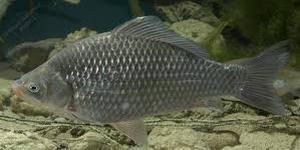
The Crusian carp (Carassius carassius) is a freshwater fish species belonging to the family Cyprinidae. It is native to Europe and Asia, and has been introduced to other parts of the world as well.
The Crusian carp is a small to medium-sized fish, typically growing to lengths of around 20-30 cm (8-12 inches). It has a stout, cylindrical body, with a small, slightly oblique mouth and a short dorsal fin. Its scales are large and golden brown in color, and its fins are generally orange-red or reddish-brown.
The carp are omnivorous and feed on a variety of foods, including insects, crustaceans, small fish, and plant matter. They are commonly found in slow-moving or still waters such as ponds, lakes, and slow-moving rivers.
Crusian carp are popular among anglers for their sport and their mild, white meat. They are also sometimes kept as ornamental fish in backyard ponds. However, in some parts of the world, they are considered invasive species due to their ability to outcompete native fish for resources.
The Crusian carp is a small to medium-sized fish, typically growing to lengths of around 20-30 cm (8-12 inches). It has a stout, cylindrical body, with a small, slightly oblique mouth and a short dorsal fin. Its scales are large and golden brown in color, and its fins are generally orange-red or reddish-brown.
The carp are omnivorous and feed on a variety of foods, including insects, crustaceans, small fish, and plant matter. They are commonly found in slow-moving or still waters such as ponds, lakes, and slow-moving rivers.
Crusian carp are popular among anglers for their sport and their mild, white meat. They are also sometimes kept as ornamental fish in backyard ponds. However, in some parts of the world, they are considered invasive species due to their ability to outcompete native fish for resources.
Ghost carp
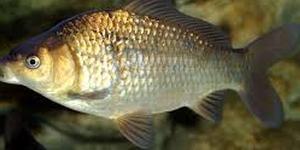
Ghost carp, also known as "ghost koi," are a color variant of the common carp (Cyprinus carpio) that have been selectively bred to produce a fish that is predominantly white with a few grey or black markings. Ghost carp are popular among fish enthusiasts and can be found in many ponds and aquariums around the world.
The carp are generally hardy fish that can tolerate a wide range of water conditions, but they require clean, well-oxygenated water with plenty of space to swim. They are omnivorous and will eat a variety of foods, including pellets, flakes, and live or frozen foods.
Like other carp, ghost carp can grow quite large if given enough space and food. They can live for many years and make interesting and entertaining pets for those who are willing to provide them with the care and attention they require.
The carp are generally hardy fish that can tolerate a wide range of water conditions, but they require clean, well-oxygenated water with plenty of space to swim. They are omnivorous and will eat a variety of foods, including pellets, flakes, and live or frozen foods.
Like other carp, ghost carp can grow quite large if given enough space and food. They can live for many years and make interesting and entertaining pets for those who are willing to provide them with the care and attention they require.
Miror carp
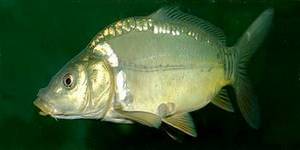
Mirror carp is a species of carp native to Europe and western Asia. It is a large fish, typically reaching lengths of up to 60 cm (24 in). Mirror carp have a silvery-green body, with a yellowish-brown to olive-brown back and upper sides.
They feed on aquatic insects, mollusks, crustaceans, small fish, and plant matter. Mirror carp are highly valued for their delicious flavor, and they are a popular fish for angling. They are also an important species in aquaculture, as they can tolerate low oxygen levels and a wide range of temperatures.
They feed on aquatic insects, mollusks, crustaceans, small fish, and plant matter. Mirror carp are highly valued for their delicious flavor, and they are a popular fish for angling. They are also an important species in aquaculture, as they can tolerate low oxygen levels and a wide range of temperatures.
©2016/2024 - carpe-amour.com